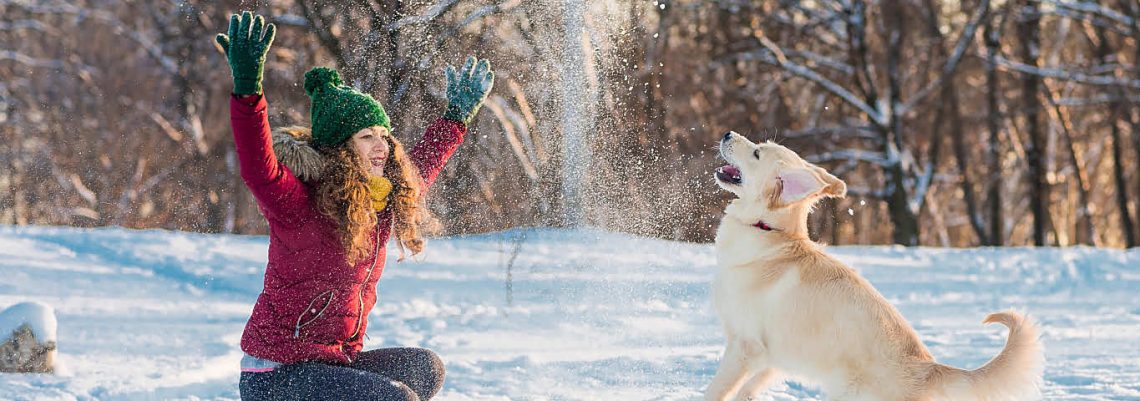
Helping old dogs in winter and snowfall
Over the years of the dog’s life, the owner has studied its oddities, unique behaviors and facial expressions, and also found out what he likes and does not like. But now the family pet has aged, and it’s time to re-examine her age needs. For pet owners living in regions with cold winters, this means paying attention to the peculiarities of caring for an old dog in the winter.
Ambient temperatures are dropping, days are getting shorter, and aging dogs face new challenges. In the winter, they face problems ranging from slippery steps and floors, freezing temperatures and damage to their paws from salt and chemicals, to arthritis, joint problems, and more. Dog owners play an important role in keeping dogs comfortable, safe and healthy during the winter months. How to walk your dog in winter
Contents
Limit exposure to extreme temperatures
The process of thermoregulation in animals, as in humans, is disturbed with age. During the winter, older dogs are at increased risk of hypothermia, frostbite, and other cold-related conditions. It is recommended to keep all dogs at home during very cold weather. To do this, you need to provide them with alternative physical activities to ensure the desired level of stimulation and activity. Throwing your dog a ball down a long hallway, hiding favorite treats or toys he’ll be looking for, and even training sessions are all great ways to keep your senior pet’s mind and body working.
If it is not possible to avoid going outside, it is important to remember that walking with an elderly pet in the snow requires extreme caution. You should also figure out how to dress your dog in winter. You can put on warm outerwear, such as a jacket or winter coat, and teach her to wear boots. When walking, do not take your dog over dangerous areas such as ice and metal manhole covers.
It is necessary to monitor the obvious signs of hypothermia in the animal: severe chills, lethargy and frostbite of the skin. Frostbite can be recognized by a bluish or whitish tint to the affected areas of the skin. The ears and tail tip of pets are especially vulnerable to frostbite, so when walking with an older dog in the snow, special attention must be paid to these parts of the body.
Prepare the house for the winter season
As dogs age, their bodies change and they become more sensitive to environmental conditions. Older dogs, regardless of breed, are more susceptible to heat and cold. When going outside on cold days, you can put a coat on your dog, and at home put an extra blanket in his bed.
It is important that at home the pet has the opportunity to quickly warm up, as well as quickly navigate the room. One of the “winter” changes can be the spreading of rugs or non-slip rugs on slippery areas of the floor. You can lay rugs in front of the front doors, where traces of snow brought from the street can remain. So the dog will always have a stable surface to walk on. All stairs should be blocked with special railings so that the four-legged friend does not stumble when going down or climbing them unattended.
You can also set aside a place near the heater or radiator to lay a special bed, such as an orthopedic one, to reduce the impact on the pet’s bones and muscles. In case of an “accident”, you should buy a waterproof cover.
How to protect paws
The paws of an older dog are incredibly susceptible to injury and pain during the winter months. Extra care must be taken to protect them from ice, snow and salt that can get stuck between the fingers and pads. The AKC (American Kennel Club) recommends cutting the hair between the dog’s toes to the level of the paw pads. This will prevent the formation of ice balls on these tufts of hair, which can cause pain to the dog and damage this extremely sensitive part of the body.
Before going outside, it is advisable to apply a special balm or wax to the dog’s paws. They will not only help them from the harmful effects of salt, ice, icy pavement and snow, but also moisturize the pads. This extra hydration effectively repairs the damage done and reduces soreness.
Before letting the dog into the house after a walk, you should carefully rinse her paws with warm water and a soft cloth. Be sure to remove any small objects that may be stuck between the fingers and pads. This way you can prevent injury to the paws and make sure that the dog does not accidentally lick off harmful substances from them. In addition, this will avoid getting salt or other chemicals on your pet’s paws into the house.
Consult with a veterinarian
In winter, older dogs are especially susceptible to bad weather, and cold temperatures can exacerbate their health problems. For older dogs, a few changes to the schedule should be made. They need to go up and down stairs as little as possible, and it is better, if possible, to take the dog in his arms to protect his joints. It’s important to make sure your four-legged friend doesn’t show obvious signs of pain or discomfort.
It’s worth talking to a qualified veterinarian about arthritis and joint problems that can develop or get worse in the winter. The specialist will give additional information with which it will be possible to make life easier for an aging pet.
Winter is a harsh season for both humans and animals. And for older dogs, this is the most difficult time when they especially need care and attention. By taking the right steps to protect your beloved dog and preparing the house for winter conditions, the owner will be sure that this winter will be the best for his pet.





